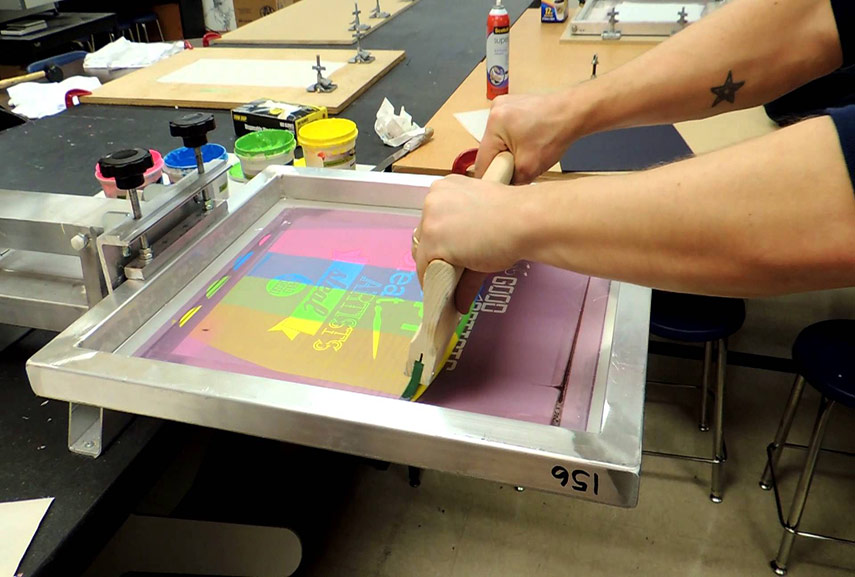ChatGPT said: How to customize your apparel with 10:9 Design Screen Printing in 3 easy steps
Discover the Numerous Types of Screen Printing Techniques for Your Following Job
Screen printing provides a diverse variety of methods that can boost any imaginative task. From standard methods like serigraphy to contemporary advancements such as direct-to-garment printing, each strategy has its distinct benefits. Specialty options, including metallic and eco-friendly inks, present a lot more opportunities. Recognizing these techniques can substantially affect the last end result. However, the obstacle lies in picking one of the most suitable method for particular needs and wanted impacts. What variables should one think about?

The Fundamentals of Screen Printing
Screen printing might appear complicated, it is basically an uncomplicated procedure that involves moving ink through a mesh screen onto numerous surface areas. The method begins with the development of a stencil, which defines the design to be printed. This stencil is affixed to a mesh screen, commonly made from polyester or nylon. As soon as the stencil is in location, ink is related to the screen and pressed via the mesh using a squeegee, causing the preferred pattern being published on the underlying product.
Screen printing can be executed on a wide variety of substratums, including plastic, material, and paper, making it a versatile choice for numerous tasks. The procedure permits for intricate layouts and vivid colors, making it popular in industries such as style, marketing, and art. Understanding these fundamentals outfits people with the fundamental knowledge needed to discover advanced methods in screen printing.
Conventional Screen Printing Techniques
Typical screen printing methods have actually been used for centuries, maintaining the workmanship and creativity of this approach. This technique utilizes a mesh screen to transfer ink onto a substratum, such as fabric or paper, enabling long-lasting and vivid designs. The procedure starts with producing a stencil, which obstructs certain locations of the screen to manage where the ink will be applied.
One popular strategy is serigraphy, commonly used for restricted editions and creative prints. One more is using water-based inks, which are environmentally friendly and provide a soft feel on textiles - 10:9 Design LLC Company. Additionally, traditional methods can include hand-operated printing, where artisans use ink with a squeegee, guaranteeing accuracy and interest to information
These techniques stay valued in the sector for their responsive top quality and the special appearances they produce, attracting both consumers and makers who value the heritage of screen printing.
Digital Screen Printing Innovations
As the need for faster production and modification in the printing market has actually surged, digital screen printing technologies have actually become a game-changer. This innovation mixes traditional screen printing techniques with electronic processes, enabling for fast prototyping and intricate designs that were formerly challenging to accomplish. One substantial development is the intro of direct-to-garment (DTG) printing, which promotes high-quality, full-color prints on numerous textiles without the need for displays. In addition, improvements in ink solutions have resulted in green alternatives that maintain dynamic colors while reducing environmental effect. The use of automated systems further enhances manufacturing, minimizing labor prices and enhancing accuracy. These advancements not only satisfy small set orders and individualized layouts but likewise enable quicker turnaround times, making them suitable for services concentrated on meeting client needs in a hectic market. Digital screen printing, as a result, stands for an essential evolution in the domain name of printing methods.
Specialty Screen Printing Methods
Checking out specialized screen printing approaches exposes a varied array of techniques that press the boundaries of imagination and capability in the printing sector. Among these, glow-in-the-dark inks provide a special aesthetic impact, making styles come active in low-light conditions. Metallic inks, recognized for their sparkling surface, add a touch of luxury to printed materials. One more innovative approach is discharge printing, which eliminates dye from the material as opposed to adding ink, causing a soft, vintage feel. High-density printing creates an elevated structure externally, boosting tactile engagement. Furthermore, water-based inks are obtaining appeal for their lively colors and reduced environmental impact. Each of these specialty methods accommodates specific layout requirements, enabling artists and brand names to produce standout items that reverberate with their audiences. By leveraging these approaches, services can raise their screen printing jobs to brand-new elevations, ensuring memorable perceptions.
Eco-Friendly Screen Printing Options
Green screen printing options are gaining grip as the market moves towards sustainability. Sustainable ink choices and making use of naturally degradable materials are key components in minimizing the environmental impact of the printing process. By taking on these practices, screen printers can add to an extra lasting future while preserving top notch results.
Sustainable Ink Selections

Biodegradable Products Usage
As the screen printing market develops, the incorporation of eco-friendly products is ending up being significantly crucial for eco aware methods. Makers and developers are now exploring inks and substrates made from natural, renewable energies that decay more effectively than standard equivalents. These naturally degradable options decrease plastic waste and lessen environmental influence, aligning with the expanding need for sustainable products.
Usual examples consist of water-based inks and natural cotton materials, both of which reduce dangerous chemicals and advertise eco-friendliness. Brand names that adopt these products frequently enhance their market appeal, drawing in customers who prioritize sustainability. As awareness of ecological concerns continues to increase, the shift in the direction of naturally degradable materials in screen printing is most likely to acquire energy, fostering a greener market standard.
Choosing the Right Technique for Your Project
Exactly how can one establish one of the most suitable screen printing method for a certain project? The decision rests on numerous aspects, consisting of the product to be printed on, the complexity of the layout, and the preferred production volume - 10:9 Design Screen Printing. For example, direct-to-garment printing is optimal for elaborate designs with numerous colors, while standard screen printing stands out for larger runs of easier graphics
Furthermore, factor to consider of the end-use of the published thing is necessary. For outside applications, methods that provide toughness and weather condition resistance, such as plastisol ink, may be favored. Conversely, environmentally-conscious jobs might take advantage of water-based inks or biodegradable products.
Eventually, recognizing the project's special needs permits an informed selection, ensuring both aesthetic charm and useful longevity. By evaluating style intricacy, material compatibility, and production scale, one can efficiently choose one of the most ideal screen printing technique to satisfy their task's goals.
Frequently Asked Inquiries
What Is the Background of Screen Printing?
Screen printing originated in ancient China around 1000 AD, advancing via Japan and Europe. By the 20th century, it ended up being preferred in commercial art and fashion, reinventing just how layouts were generated and dispersed internationally.

Exactly how Do I Prepare Art Work for Screen Printing?
To prepare artwork for screen printing, one need to guarantee high resolution, make use of an ideal color setting, produce separate layers for every color, and transform text to details, ensuring compatibility with the printing procedure and preferred outcome.
What Materials Are Finest for Screen Printing?
The most effective products for screen printing include top quality inks, resilient displays, and ideal substrates like cotton, polyester, or blends. Furthermore, utilizing suitable emulsion and squeegees can boost the printing procedure and results.
Can I Evaluate Publish in the house?
Yes, screen printing in your home is feasible. With the ideal materials, configuration, and strategies, people can produce top quality prints. However, careful consideration of work area and devices is important for effective results.

What Prevail Errors in Screen Printing?
Typical errors in screen printing consist of inappropriate direct exposure times, insufficient ink uniformity, imbalance of displays, insufficient cleansing of products, and disregarding to check prints. These mistakes can endanger the high quality and accuracy of the end product.
Screen printing might appear complicated, it is fundamentally a straightforward process that entails moving ink via a mesh screen onto various surfaces. As the demand for faster manufacturing and customization in the printing industry has surged, digital screen printing technologies have arised as a game-changer. Exploring specialized screen printing approaches exposes a diverse array of methods that push the borders of imagination and capability in the printing industry. The best materials for screen printing consist of high-quality inks, sturdy screens, and ideal substratums like cotton, polyester, or blends (10:9 Design Embroidery). Common mistakes in screen printing consist of improper exposure times, insufficient ink consistency, imbalance of screens, insufficient cleaning of materials, and neglecting to evaluate prints